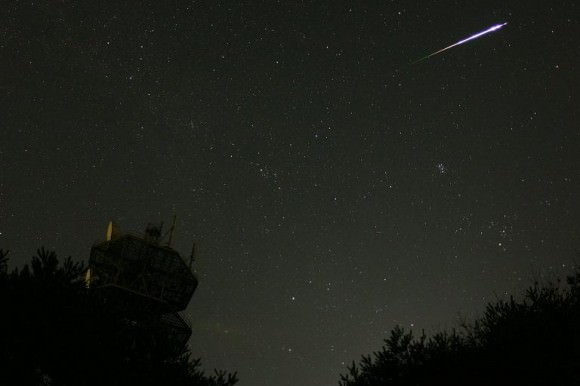Caption: A bright fireball meteor on August 1, 2012. Credit: John Chumack.
This will probably be the most simple and easiest guide to viewing the Perseids and other meteor showers you may possibly ever read. The reason why it is so simple is when you are outside you want to concentrate on looking for meteors and not worrying about technical details, which are unnecessary for the casual observer.
First, a LITTLE about the Perseids: The Perseid meteor shower is an annual event occurring every August. They are tiny particles of dust and debris from the tail of a comet (109P/Swift-Tuttle) which planet Earth encounters every year in its orbit around the Sun. When these particles collide with the Earth’s atmosphere, they burn up causing bright flashes and streaks in the night sky. These are known as shooting stars or meteors.

To see Perseids (shooting stars/meteors) we only need to do a few simple things.
- Plan when you want to look for meteors: Check timings and set aside a good hour or more for observing (away from bright lights if possible). Meteors seldom appear immediately so give yourself a good hour or more to see as many as possible. Late evening and after midnight is a good time for meteor hunting. One of the best time to look, however, is during the dark hours immediately before dawn. There are some good guides with timings, etc. on www.meteorwatch.org, NASA, or Universe Today’s weekly SkyWatcher’s Forecast
- Get comfortable: Dress warmly as even in August it can get chilly at night. Find yourself a good garden chair, deck chair, trampoline or place on the ground you can lay a sleeping bag or blanket, as the idea is for you to keep your gaze on the sky for as long as possible. Lying down on the ground or sitting on a reclining garden chair will make this much easier for you. Take with you food and drink to make the evening even more enjoyable.
- Where to look: A lot of guides will tell you to look in certain directions at certain times and be far too technical, this is totally unnecessary. All you need to do is look up and fill your gaze with sky for as long as possible (blink and you miss it). Meteors/shooting stars from meteor showers tend to appear randomly all over the sky, they will however originate from a point called the radiant which gives the meteor shower its name the Perseids radiant/point of origin is in the constellation of Perseus, hence the name. You don’t need to look in any particular direction, just look up.
- How to look: You do not need a telescope, binoculars or any other viewing aid; you only need your eyes.
- What to expect: Don’t expect to see the heavens raining down with fire. Expect to see one or more bright flashes/ streaks of light (meteors/shooting stars) every few minutes. The Perseids can deliver fifty to a hundred meteors per hour at their peak, which is just after the night of the 11th and 12th August through to the 13th and 14th August, be patient and you will see some. Occasionally you may be lucky to see an incredibly bright meteor known as a fireball, these are a real treat. Also, as an added bonus this year, Jupiter, Venus, and the crescent Moon are gathering together in the night sky just as the Perseid meteor shower reaches its peak.
Enjoy yourself and keep looking up, the more you look up the more you will see. When you look away that’s when you miss the best meteor of the evening.
For further information and to join in with the worldwide #meteorwatch on twitter follow @virtualastro and visit meteorwatch.org
Good luck!


Back in the early 90’s, I belonged to an astronomy club called, ‘The Wragg Canyon Star Gazers”. We met every weekend nearest the new moon and for special events, like meteor showers, C. Shoemaker/Levy 9’s Jupiter smashup and etc. In 1994 we were privy to a Perseid Meteor STORM! We counted over 380 meteors per hour! It was AWESOME! I thought I’d done died and gone to ‘Meteor Watcher’s Heaven’. How do you beat that? THEN in 2001, the Leonids did their thang @ +1,000 meteors per hour!
Now… I try to catch as many meteor showers as I can… cuz, yah just never know what will happen!
http://goo.gl/vg2lR
A little Pink Floyd music in the background wouldn’t hurt, either. (With clear skies, who needs a planetarium?)
🙂
This guide doesn’t tell me how to get rid of all the clouds and rain on the best shooting star weekend of the summer!!
Clouds aside stay safe and wear a protective football helmet when outside day or night for the next 72 hours
we have excellent conditions in my area this year. i’m about to head out right now!
I totally saw a fireball!! (^^,)